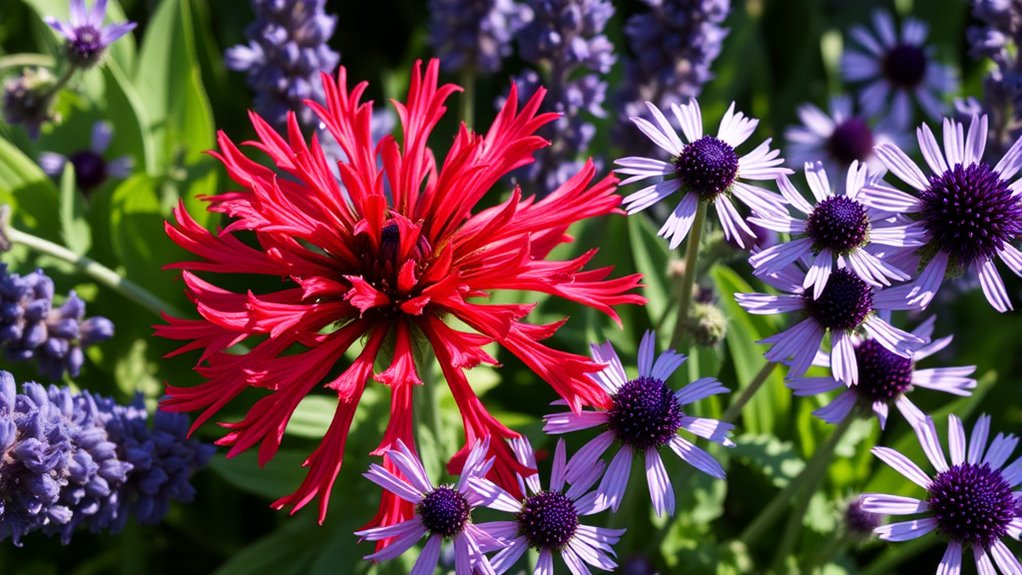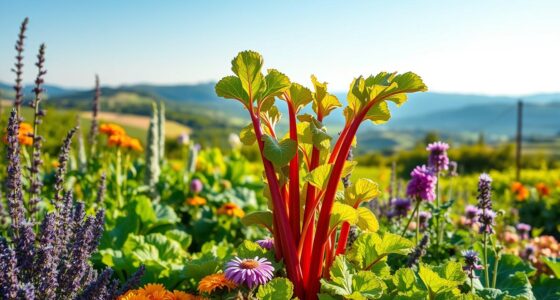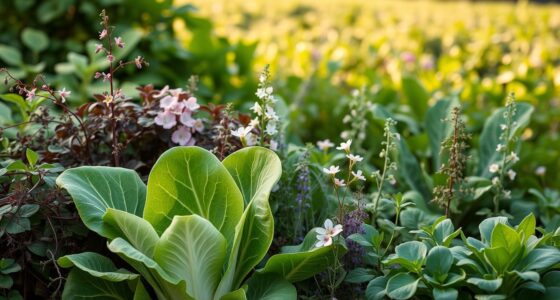Planting herbs like basil, oregano, and chives nearby can attract pollinators and repel pests around your bee balm. Flowers such as coneflowers, Black-eyed Susans, and white daisies draw in bees and butterflies, enhancing pollination and adding visual appeal. Ornamental grasses and leguminous plants like lupines support ecological balance and natural pest control. Incorporating pest-repellent plants like marigolds and nasturtiums further protects your garden. To uncover more effective companion strategies, keep exploring these options.
Key Takeaways
- Plant aromatic herbs like basil, oregano, and chives nearby to attract pollinators and repel pests such as aphids and mosquitoes.
- Pair bee balm with coneflowers, black-eyed Susans, and white daisies to enhance pollination and create vibrant visual contrasts.
- Incorporate white flowers and ornamental grasses to add aesthetic appeal, texture, and movement while supporting pollinators.
- Use leguminous plants, marigolds, and nasturtiums to attract beneficial insects, suppress weeds, and naturally manage pests.
- Strategically position nasturtiums and marigolds as living barriers for pest control and to improve overall garden health.
Basil and Other Aromatic Herbs

Planting basil and other aromatic herbs nearby can boost bee balm’s growth and attract more pollinators. These herbs release scents that attract bees, butterflies, and beneficial insects, enhancing pollination for your bee balm. Basil’s strong aroma not only draws pollinators but also helps repel pests like aphids and mosquitoes, creating a healthier environment for your plants. Other aromatic herbs such as oregano, thyme, and chives work similarly, offering scent-based attraction while providing additional culinary or medicinal value. Plant these herbs close to bee balm to create a fragrant, pest-resistant garden that encourages lively pollinator activity. This symbiotic relationship benefits both the herbs and bee balm, leading to more vibrant blooms and a thriving pollinator population in your garden. Additionally, incorporating just candles into garden decor can add a charming ambiance during evening visits. Utilizing companion planting techniques can further improve plant health and productivity. Moreover, choosing sustainable gardening practices can help protect local ecosystems and promote biodiversity.
Echinacea and Coneflower
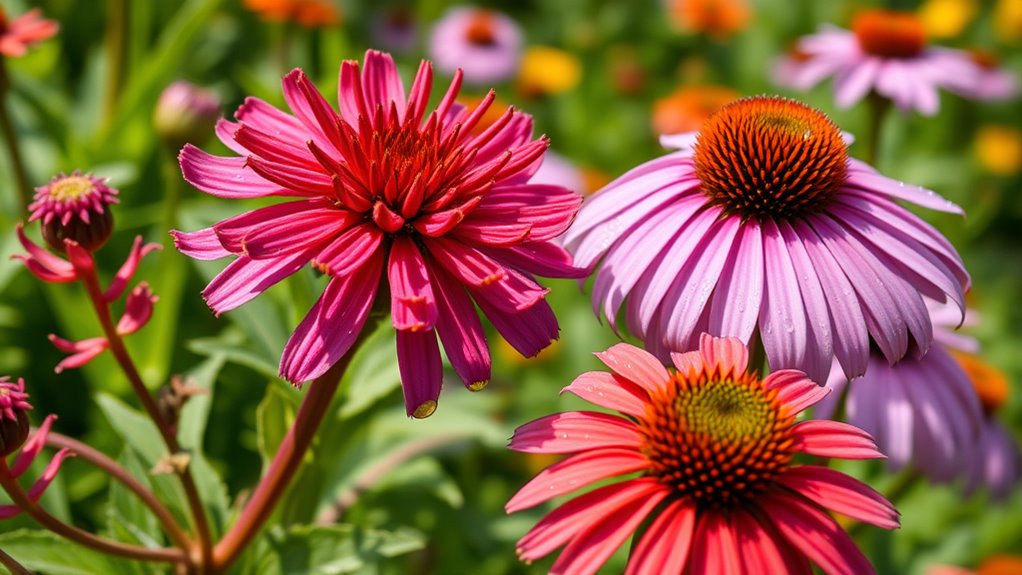
Echinacea and coneflowers are excellent companions for bee balm because they attract a wide range of pollinators and thrive in similar growing conditions. Both plants prefer full sun and well-drained soil, making them easy to grow together. Their vibrant, daisy-like flowers provide continuous nectar and pollen, encouraging bees, butterflies, and other beneficial insects to visit your garden. Planting them near bee balm creates a lively, pollinator-friendly environment that boosts overall garden health. Echinacea and coneflowers also add visual appeal with their striking blooms and sturdy foliage. Their overlapping blooming periods ensure your garden stays colorful and pollinator-active throughout the growing season. Together, these plants support pollinator populations and enhance the beauty of your garden. Maintaining a pollinator-friendly environment is essential for a healthy and thriving garden ecosystem. Incorporating companion planting strategies can further improve plant health and productivity. Additionally, selecting plants that are resilient to local pests can help reduce maintenance and protect your garden’s diverse ecosystem.
Black-eyed Susan (Rudbeckia)
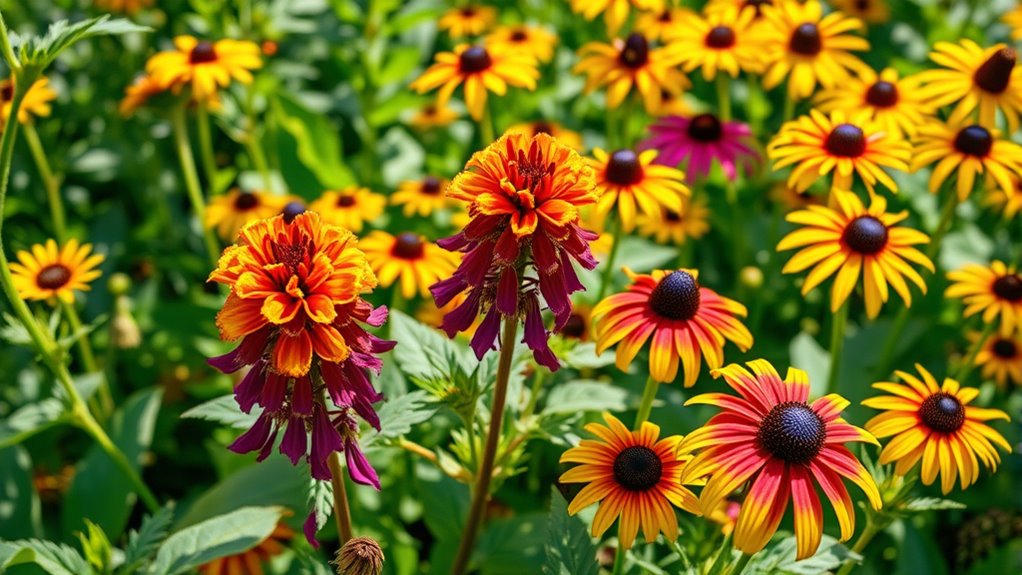
Black-eyed Susan (Rudbeckia) makes a vibrant complement to bee balm, adding bold, sunny blooms that attract pollinators and brighten your garden. Its bright yellow petals and dark centers create a striking contrast against bee balm’s colorful, tubular flowers. Planting these together encourages a lively, pollinator-friendly environment, as both attract bees, butterflies, and other beneficial insects. Black-eyed Susan thrives in full sun and well-drained soil, making it easy to care for alongside bee balm. Its long-lasting blooms extend your garden’s color from summer into fall. You’ll enjoy a seamless, natural look while supporting pollinator health. Combining these plants not only enhances visual appeal but also boosts your garden’s ecological value, creating a cheerful, dynamic landscape. Using vetted textile lines can help support sustainable gardening practices and add durability to garden markers or accessories. Incorporating pollinator-friendly plants like black-eyed Susan and bee balm can further promote a healthy, thriving garden ecosystem. Additionally, selecting plants with appropriate growth habits ensures a balanced and manageable garden design, encouraging continual growth and pollination. Choosing plants that are adaptable to various soil conditions can help reduce maintenance needs and foster a more resilient garden environment. Proper plant pairing can also help reduce the need for chemical interventions, fostering a more eco-friendly garden environment.
Shasta Daisy and Other White Blooms
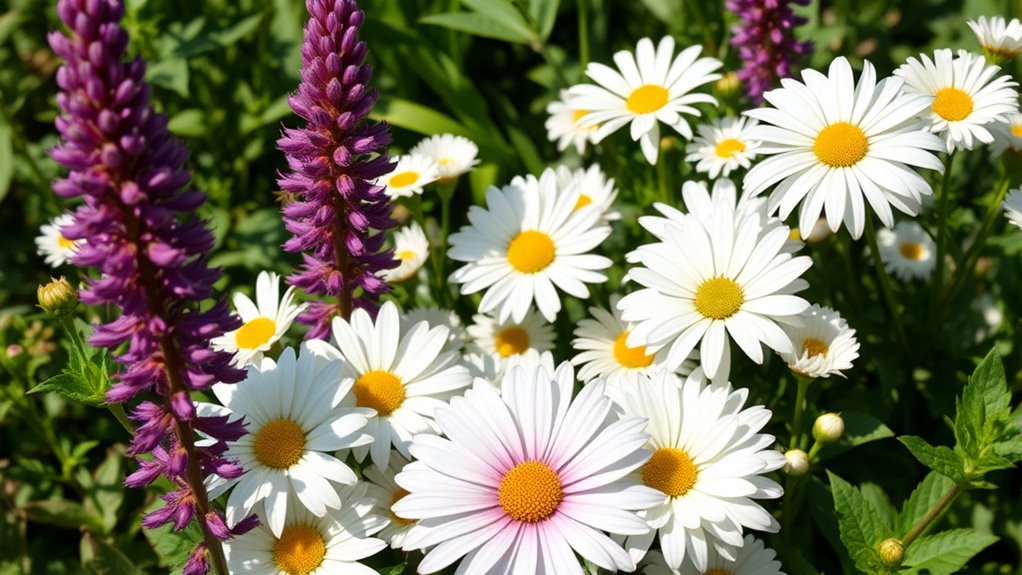
Shasta daisies and other white blooms create a striking contrast next to bee balm, enhancing your garden’s visual appeal. They also attract pollinators naturally, boosting your plants’ health and productivity. Plus, their crisp white color adds a fresh, clean look to your flower beds. Incorporating companion planting techniques can further improve garden health and aesthetics. Additionally, choosing plants with complementary traits can help create a more resilient and thriving garden ecosystem. Selecting plants with similar sunlight and water needs ensures a harmonious and low-maintenance garden environment. To maximize their benefits, consider arranging these plants to promote interplant diversity, which can help prevent pests and diseases while supporting pollinator activity. Embracing curiosity about plant interactions can lead to more innovative and successful gardening strategies.
Complementary White Flowers
White flowers like Shasta daisies and other similar blooms make excellent companions for bee balm because they provide a striking contrast that highlights the vibrant reds and purples of your garden. These blooms brighten the space and create a fresh, clean backdrop for your colorful plants. To maximize their effect, consider these options:
- Shasta Daisies: Their large, white petals and yellow centers complement bee balm’s bold hues.
- Yarrow: White yarrow adds texture and attracts beneficial insects.
- Coreopsis: White varieties, when paired with bee balm, enhance visual interest and maintain a cohesive look.
Plantting these together creates a harmonious display that emphasizes your garden’s lively colors while maintaining a balanced, airy feel.
Attracting Pollinators Naturally
By planting white blooms like Shasta daisies and yarrow, you can naturally attract a variety of pollinators to your garden. These bright, easily visible flowers draw bees, butterflies, and other beneficial insects seeking nectar and pollen. White flowers tend to stand out against leafy foliage, making them highly attractive to pollinators during different times of the day. As pollinators visit these blooms, they help improve the overall health and productivity of your garden by increasing pollination for bee balm and nearby plants. Keep these flowers well-maintained and in sunny spots to maximize their appeal. Incorporating such blooms creates a lively, pollinator-friendly environment that supports your garden’s ecosystem without the need for artificial attractants. Additionally, data analysis by AI can help identify the most effective plant varieties and flowering times to optimize pollinator visits.
Enhancing Garden Aesthetics
Adding white blooms like Shasta daisies and yarrow to your garden instantly elevates its visual appeal, creating a clean and timeless look. These flowers provide a bright contrast to colorful plants and can serve as a unifying element throughout the season. To maximize their impact, consider these tips:
- Plant them near Bee Balm to highlight its vibrant colors and attract pollinators.
- Use them as a border to define garden edges with a crisp, elegant line.
- Combine different white flowers for varied textures and heights, adding depth and interest.
White blooms act as a neutral backdrop, making other colors pop. They bring balance and sophistication while enhancing your garden’s overall aesthetic. Incorporate these plants thoughtfully for a harmonious, eye-catching landscape.
Ornamental Grasses for Texture and Movement
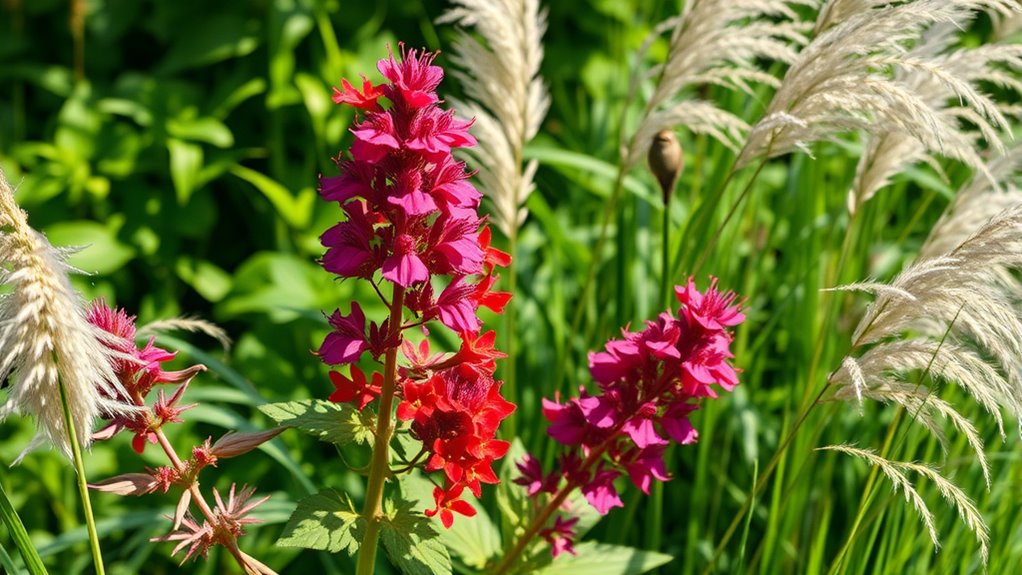
Adding ornamental grasses brings movement and texture to your garden, making it more dynamic. They create a beautiful contrast with the soft blooms of bee balm and help guide the eye through your landscape. This combination enhances garden flow and adds visual interest throughout the seasons. Incorporating visual interest through different plant textures can create a more engaging garden experience. Water features incorporated nearby can further amplify the serene and lively atmosphere created by this plant pairing. When selecting grasses, consider varieties that complement the preppy aesthetic of your garden design for a cohesive look. Selecting appropriate planting techniques ensures your ornamental grasses thrive alongside bee balm, enhancing their visual impact. Additionally, choosing grasses with suitable growth habits will help maintain a balanced and harmonious garden layout.
Enhancing Garden Dynamics
Incorporating ornamental grasses into your garden can markedly enhance its visual appeal by introducing texture and movement. These grasses create dynamic layers that draw the eye and add seasonal interest. To maximize garden harmony, consider:
- Selecting varieties with contrasting heights and colors to highlight Bee Balm’s vibrant blooms.
- Placing taller grasses behind your bee balm to create a natural backdrop and emphasize its shape.
- Using clumping grasses to add rhythm and flow, making your garden feel lively and engaging.
- Researching garden design principles can help you arrange these elements effectively for a balanced landscape.
- Additionally, understanding the importance of visual balance in garden design can help you create a cohesive and aesthetically pleasing space.
- Incorporating public gardens and landscape examples can provide inspiration and practical ideas for combining ornamental grasses with bee balm.
- Exploring different plant combinations can further enhance the harmony and visual interest of your garden, encouraging ongoing experimentation and creativity.
These grasses sway gently in the breeze, providing a sense of movement that complements the bold, colorful flowers. Their varied textures and forms help create a balanced, lively landscape that showcases Bee Balm’s beauty while enriching overall garden dynamics.
Complementary Textural Contrasts
Pairing Bee Balm with ornamental grasses that offer contrasting textures creates a richer, more engaging garden scene. The soft, fuzzy foliage of Bee Balm contrasts beautifully with the wiry, blade-like leaves of grasses like fountain grass or switchgrass. These grasses add vertical interest and movement, catching the breeze and bringing your garden to life. Their fine or coarse textures highlight the bold, rounded blooms of Bee Balm, emphasizing its vibrant colors. Mixing these textures adds depth and complexity, making your planting bed more dynamic. Additionally, grasses require minimal maintenance and tolerate drought, balancing the moisture-loving Bee Balm. The combination offers a striking visual interplay, ensuring your garden remains lively and inviting throughout the seasons.
Creating Visual Flow
To create visual flow in your garden, select ornamental grasses that move gracefully with the breeze and guide the eye smoothly across your planting beds. These grasses add a sense of movement and softness, balancing the bold presence of bee balm. Consider these options:
- Switchgrass (Panicum virgatum): Its airy plumes sway gently, creating a flowing backdrop.
- Fountain Grass (Pennisetum alopecuroides): Its rounded seed heads add texture and rhythm.
- Little Bluestem (Schizachyrium scoparium): Its upright form and bluish hue provide contrast while leading the eye through the garden.
Mix and position these grasses thoughtfully to enhance visual continuity, helping your garden feel lively and cohesive.
Coreopsis and Other Bright Perennials

Adding coreopsis and other bright perennials to your bee balm garden creates a vibrant, eye-catching display that attracts pollinators. Bright yellow, orange, and golden blooms from coreopsis contrast beautifully with bee balm’s bold reds, purples, and pinks. These perennials bloom at different times, extending the garden’s color throughout the season. Their sunny hues naturally draw bees, butterflies, and hummingbirds, increasing pollination. Plus, their varied heights add depth and structure, making the garden more dynamic. Select varieties that thrive in your climate and soil for the best results. Incorporating these bright perennials not only enhances visual appeal but also supports pollinator activity, creating a lively, thriving garden ecosystem that benefits all your plants.
Yarrow and Its Pollinator-Attracting Qualities
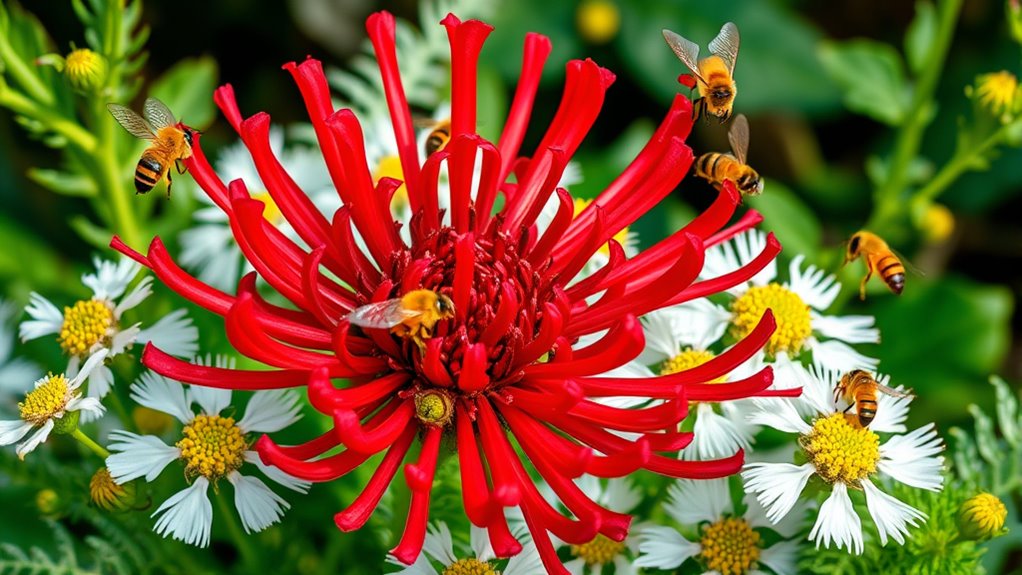
Yarrow is a standout companion plant for bee balm because of its exceptional ability to attract a wide variety of pollinators. Its flat-topped clusters of tiny flowers provide an easy landing platform, encouraging bees, butterflies, and beneficial insects to visit. By planting yarrow nearby, you’ll boost pollination rates for your bee balm and other garden blooms.
Here are three key benefits of yarrow:
- Draws in diverse pollinators, increasing overall garden activity.
- Extends flowering season, providing nectar when other plants fade.
- Acts as a pest repellent, helping protect bee balm from unwanted visitors.
Integrating yarrow into your garden creates a vibrant, pollinator-friendly environment that benefits all your flowering plants.
Lupines and Leguminous Companions
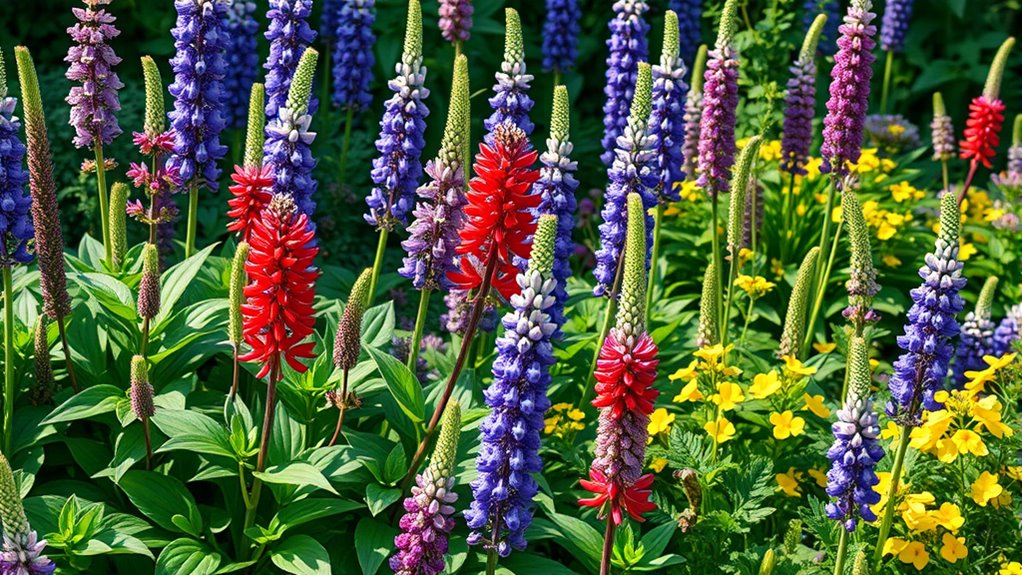
Lupines and other leguminous plants can boost your garden’s soil fertility naturally by fixing nitrogen. They also attract beneficial insects that help keep pests in check. Incorporating these companions alongside bee balm creates a healthier, more balanced garden ecosystem.
Enhancing Soil Fertility
Because legumes like lupines have the ability to fix nitrogen in the soil, planting them alongside bee balm can substantially boost soil fertility. This natural process enriches the soil, benefiting nearby plants. To maximize this effect, consider these steps:
- Select healthy lupines that are free of disease to ensure effective nitrogen fixation.
- Plant lupines close to bee balm but with enough space to grow without competition.
- Rotate leguminous plants annually to prevent soil exhaustion and maintain soil health.
Attracting Beneficial Insects
Planting lupines and other leguminous companions nearby can substantially boost your garden’s health by attracting beneficial insects. These plants produce nectar and pollen that draw in pollinators like bees and butterflies, which help increase the pollination of your bee balm. Additionally, leguminous plants attract predatory insects such as ladybugs, lacewings, and parasitic wasps, which naturally control pest populations. As these beneficial insects visit your garden, they help keep harmful pests in check, reducing the need for chemical interventions. Lupines also create a diverse habitat, encouraging a balanced ecosystem. By including these companions, you not only support pollination but also foster a natural pest control system, making your garden healthier and more resilient.
Nasturtiums for Pest Control and Edible Blooms
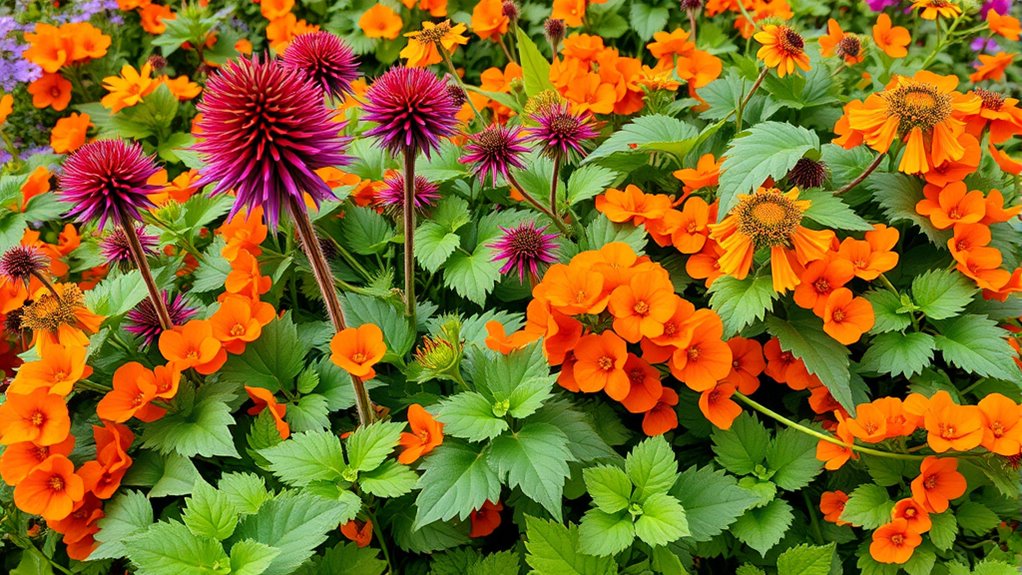
Nasturtiums are an excellent companion plant for bee balm because they naturally repel pests like aphids and whiteflies, helping to protect your garden. Their vibrant blooms attract pollinators and serve as a trap crop for harmful insects, keeping your bee balm healthy. Plus, nasturtiums offer edible flowers and leaves that add flavor to salads and garnishes. To maximize their benefits, consider these tips:
- Plant nasturtiums near bee balm to deter pests early.
- Use them as a living mulch to suppress weeds and retain moisture.
- Harvest their edible blooms regularly for culinary use and continuous pest attraction.
Integrating nasturtiums enhances both pest control and the visual appeal of your garden, creating a thriving, vibrant space.
Marigolds and Their Pest-Repellent Properties
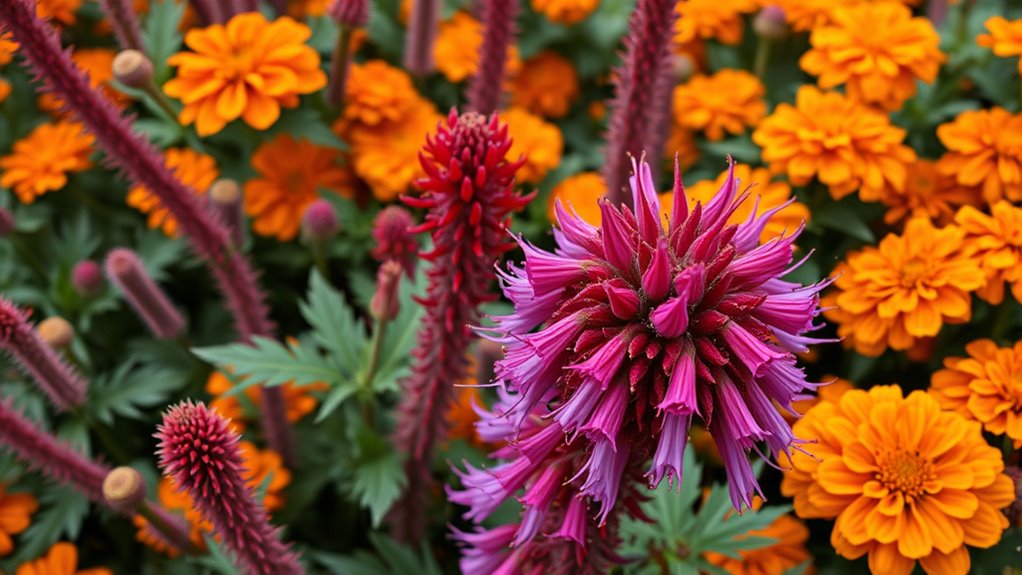
Marigolds are renowned for their natural pest-repellent properties, making them a valuable addition to your bee balm garden. Their strong scent deters common pests like aphids, nematodes, and beetles, reducing the need for chemical treatments. Planting marigolds nearby creates a protective barrier, helping keep pests away from your bee balm. Additionally, marigolds release compounds into the soil that inhibit harmful nematodes, promoting healthier plant roots. To maximize their benefits, consider the following:
| Pest Deterrent | Marigold Type | Affected Plants |
|---|---|---|
| Aphids | French Marigolds | Bee Balm, Tomatoes |
| Nematodes | African Marigolds | Vegetables, Herbs |
| Beetles | Signet Marigolds | Various Flowers |
| Mosquitoes | Tagetes | Outdoor Seating Areas |
| Fungus | Marigold Extract | Fungal Diseases |
This synergy enhances garden health and reduces pest pressure naturally.
Frequently Asked Questions
Which Companion Plants Help Extend Bee Balm’S Blooming Period?
You want to extend bee balm’s blooming period, so choosing the right companion plants helps. Consider adding plants like coneflowers, black-eyed Susans, or coreopsis, which bloom at different times. These flowers attract pollinators and provide continuous color. By planting a mix of these, you create a vibrant garden that blooms longer, supports pollinators, and enhances your landscape’s visual appeal throughout the season.
Are There Any Vegetables Suitable as Bee Balm Companions?
A penny for your thoughts, but vegetables can be great companions for bee balm. You might plant herbs like basil or chives nearby, as they attract pollinators and deter pests. Leafy greens such as lettuce or spinach also work well, offering ground cover and helping conserve moisture. These vegetables not only support bee balm’s health but also maximize your garden space, proving that good things often come in small, tasty packages.
How Do I Prevent Bee Balm From Overshadowing Nearby Plants?
To prevent bee balm from overshadowing nearby plants, you should space it properly, giving each plant enough room to grow without crowding. Regularly prune or deadhead bee balm to control its size and promote airflow. Choose companions with similar sun and water needs, and plant taller species at the back of your garden beds. This way, bee balm won’t dominate your garden, and all plants can thrive.
Can Certain Trees Benefit Bee Balm Growth and Pollination?
You wonder if certain trees can benefit bee balm’s growth and pollination. Some trees, like flowering dogwoods or serviceberries, provide early-season shade, helping maintain soil moisture and protecting bee balm from harsh sun. Others, like fruit trees, attract pollinators that also visit bee balm. By choosing trees that offer partial shade and attract pollinators, you support healthier bee balm growth and boost its chances of successful pollination.
What Flowers Attract the Same Pollinators as Bee Balm?
You want to attract the same pollinators as bee balm, so plant flowers like coneflowers, black-eyed Susans, and lavender nearby. These plants draw bees, butterflies, and hummingbirds, just like bee balm does. By providing a variety of nectar-rich blooms, you create a vibrant pollinator habitat. This not only supports bee balm’s pollination but also boosts overall garden health and diversity, making your yard a buzzing, blooming paradise.
Conclusion
By thoughtfully pairing bee balm with these charming companions, you create a lively garden that gently invites pollinators to stay awhile. These plants work harmoniously, offering subtle support and adding delightful variety. As your garden blossoms, you’ll find a peaceful rhythm unfolding—each flower playing its part in a nurturing dance. Embrace these natural partnerships, and watch your garden flourish with vibrant energy and sweet, buzzing life.
